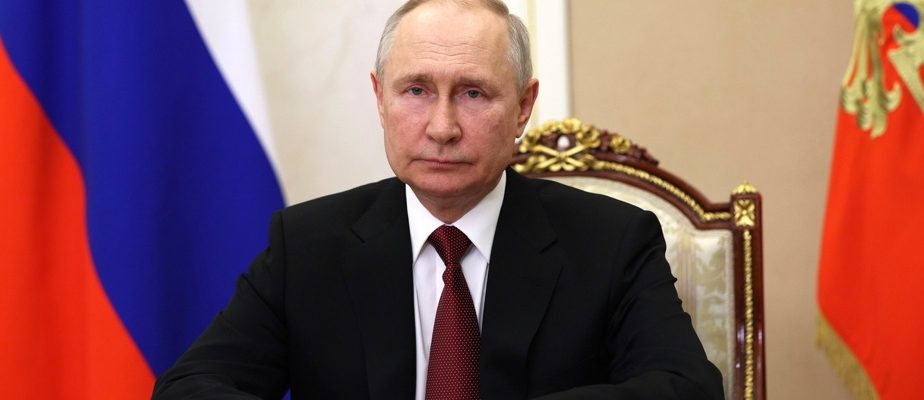(Moscow) Russia is trying Monday to give the image of a return to normal with the lifting of security measures introduced during the uprising of the paramilitary group Wagner, an unprecedented crisis which crystallizes for Westerners the fragility of Vladimir Cheese fries.
Defense Minister Sergei Shoigu, who vanished during the rebellion of Wagner boss Evgeny Prigojine, his pet peeve, reappeared Monday in a video inspecting forces engaged in Ukraine.

PHOTO FROM A VIDEO OF THE RUSSIAN MINISTRY OF DEFENSE, PROVIDED BY AGENCE FRANCE-PRESSE
Russian Defense Minister Sergei Shoigu (center)
For his part, Putin appeared for the first time since the end of the revolt on Saturday evening in a video from the Kremlin in which he addresses a forum devoted to youth and industry. There is no word of the mutiny and it was not possible to determine where and when the footage was recorded.
According to the Kremlin, he also spoke with Iranian President Ebrahim Raisi and the Emir of Qatar Sheikh Tamim bin Hamad Al-Thani who both expressed their “support” for the Russian leader following the armed rebellion of Wagner.
Mr. Putin has not publicly mentioned these events since his televised address on Saturday, in the midst of the crisis, in which he accused Mr. Prigozhin of treason.
Another sign of this effort to return to normal on Monday, the authorities announced the end of the “anti-terrorist operation regime”, which confers expanded powers on the security forces, in the Moscow region and that of Voronezh, in the south of the capital, where Wagner units had entered and firefights took place.
Prigozhin, a businessman who was an ally of Mr Putin in charge of many of Russia’s dirty tricks, ended his rebellion on Saturday night, in exchange for immunity for him and his men after mediation by the president Belarusian.
But on Monday, Russian news agencies all reported that the criminal investigation targeting Prigozhin for “calling for armed mutiny” was still ongoing.
The mystery was total as to the whereabouts of the head of Wagner who has not communicated since Saturday evening and while, according to the Kremlin, he must go into exile in Belarus, which the person concerned does not has not confirmed.

PRIGOJIN PRESS SERVICE ARCHIVE PHOTO, PROVIDED BY ASSOCIATED PRESS
Yevgeny Prigozhin
Another enigma: what fate for the 25,000 men whom Wagner says he has. Are they in their camps in Ukraine, or in bases in Russia? And passed under the orders of the Russian Ministry of Defense, or still autonomous?
Despite the apparent normality displayed on Monday, Wagner’s spectacular rebel spree between Friday night and Saturday night shook the country.
For 24 hours, Mr. Prigojine’s forces seized several military sites in the strategic city of Rostov (southwest) and traveled 600 km towards Moscow, visibly encountering little resistance.
In Rostov, his men were even cheered on as they left military headquarters for the war in Ukraine which they had managed to take.

PHOTO ARCHIVES ASSOCIATED PRESS
Members of Wagner
“Cracked” Russian Regime
If the coup ended as suddenly as it began, this crisis represents the greatest challenge that Vladimir Putin has faced since he came to power in 1999.
Scrutinized in all the chancelleries, this crisis “reveals real cracks” at the highest level of the Russian state, said Sunday the American Secretary of State Antony Blinken.
“The fact that you have someone on the inside questioning Putin’s authority and directly questioning why he launched this aggression of Ukraine, that in itself is something very powerful,” he said.
Even aborted, the Wagner mutiny shows that the war in Ukraine is in the process of “cracking” Russian power, EU diplomacy chief Josep Borrell said on Monday, judging “more important than ever to support Ukraine “.
He was speaking ahead of a meeting on Monday of European foreign ministers in Luxembourg, who must confirm a new allocation of 3.5 billion euros intended to finance their arms supplies to Ukraine and military missions there. foreign.
Wagner’s mutiny shows that the assault on Ukraine was a “strategic error”, NATO chief Jens Stoltenberg added on Monday.
“Putin and the state have received a big blow that will have significant consequences for the regime,” said independent Russian analyst Tatiana Stanovaya.
By launching his mutiny, the head of Wagner had promised to “liberate the Russian people”, targeting his two sworn enemies, Sergei Shoigu and the chief of staff Valéri Guérassimov whom he accuses of having sacrificed tens of thousands of soldiers. men in Ukraine.
If Mr. Gerasimov has not appeared in public since the crisis, the images of Mr. Shoigu visiting troops in Ukraine released on Monday seem intended to ensure that he is in charge.
We see the minister listen serenely to a general’s report, study maps and inspect Russian positions by helicopter.
It was impossible to independently verify the shooting date of these images.
In Ukraine, many analysts believe that the crisis in Russia could weaken Russian forces on the ground and benefit those in Kyiv, which have been leading a difficult counter-offensive for several weeks.
On Monday, Ukrainian Deputy Defense Minister Ganna Maliar announced modest further progress, as the Ukrainian army nibbling 17 km of additional ground against Moscow’s forces, or 130 km2 since early June. She said that the locality of Rivnopil, on the southern front, in the Donetsk region, had been taken over.
